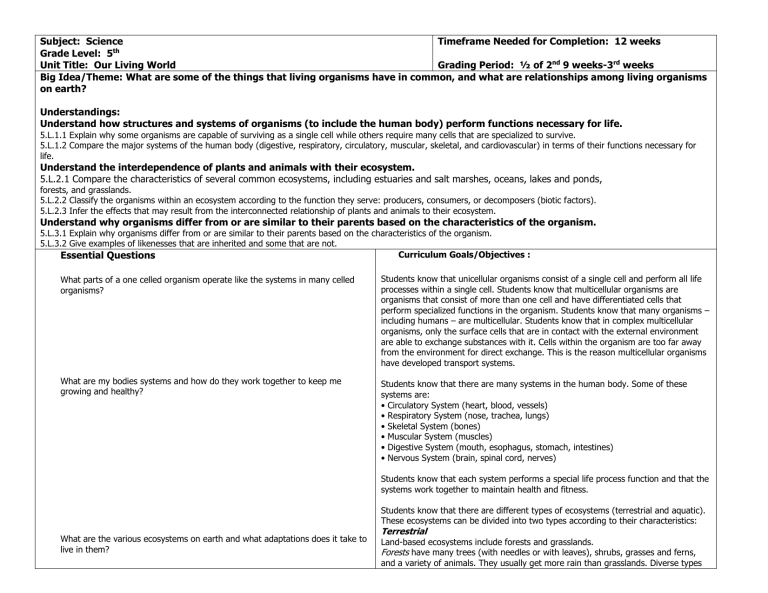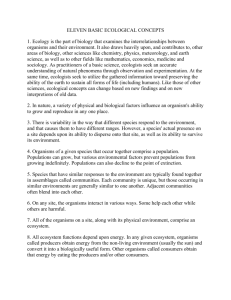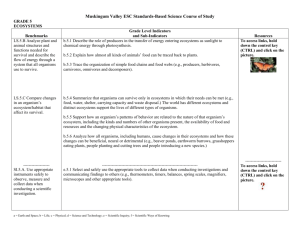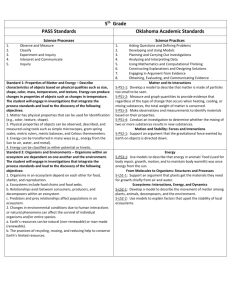Living Things

Subject: Science
Grade Level: 5 th
Unit Title: Our Living World
Timeframe Needed for Completion: 12 weeks
Grading Period: ½ of 2 nd 9 weeks-3 rd weeks
Big Idea/Theme: What are some of the things that living organisms have in common, and what are relationships among living organisms on earth?
Understandings:
Understand how structures and systems of organisms (to include the human body) perform functions necessary for life.
5.L.1.1 Explain why some organisms are capable of surviving as a single cell while others require many cells that are specialized to survive.
5.L.1.2 Compare the major systems of the human body (digestive, respiratory, circulatory, muscular, skeletal, and cardiovascular) in terms of their functions necessary for life.
Understand the interdependence of plants and animals with their ecosystem.
5.L.2.1 Compare the characteristics of several common ecosystems, including estuaries and salt marshes, oceans, lakes and ponds, forests, and grasslands.
5.L.2.2 Classify the organisms within an ecosystem according to the function they serve: producers, consumers, or decomposers (biotic factors).
5.L.2.3 Infer the effects that may result from the interconnected relationship of plants and animals to their ecosystem.
Understand why organisms differ from or are similar to their parents based on the characteristics of the organism.
5.L.3.1 Explain why organisms differ from or are similar to their parents based on the characteristics of the organism.
5.L.3.2 Give examples of likenesses that are inherited and some that are not.
Essential Questions Curriculum Goals/Objectives :
What parts of a one celled organism operate like the systems in many celled organisms?
What are my bodies systems and how do they work together to keep me growing and healthy?
What are the various ecosystems on earth and what adaptations does it take to live in them?
Students know that unicellular organisms consist of a single cell and perform all life processes within a single cell. Students know that multicellular organisms are organisms that consist of more than one cell and have differentiated cells that perform specialized functions in the organism. Students know that many organisms – including humans – are multicellular. Students know that in complex multicellular organisms, only the surface cells that are in contact with the external environment are able to exchange substances with it. Cells within the organism are too far away from the environment for direct exchange. This is the reason multicellular organisms have developed transport systems.
Students know that there are many systems in the human body. Some of these systems are:
• Circulatory System (heart, blood, vessels)
• Respiratory System (nose, trachea, lungs)
• Skeletal System (bones)
• Muscular System (muscles)
• Digestive System (mouth, esophagus, stomach, intestines)
• Nervous System (brain, spinal cord, nerves)
Students know that each system performs a special life process function and that the systems work together to maintain health and fitness.
Students know that there are different types of ecosystems (terrestrial and aquatic).
These ecosystems can be divided into two types according to their characteristics:
Terrestrial
Land-based ecosystems include forests and grasslands.
Forests have many trees (with needles or with leaves), shrubs, grasses and ferns, and a variety of animals. They usually get more rain than grasslands. Diverse types
How do producers, consumers, and decomposers fit into food chains and food webs?
What traits and characteristics do I get from my parents and what traits and characteristics are my very own? of animals can be found in forests, depending on their type. Deciduous: black bear, deer, red fox, vole, rabbit, cardinal. Rain forest: panther, monkeys, capybara, snakes, spiders. Temperatures in the forests may vary depending on where the forest is located.
Grasslands have fertile soil and are covered with tall grasses. They usually get a medium amount of rain, but less than forests. Temperatures may also vary depending on where the grassland is located. Some examples of animals that live in the grasslands are prairie dogs, bison, and grasshoppers.
Aquatic
Water-based ecosystems may be fresh water (lakes and ponds) or saltwater (oceans, estuaries and saltwater marshes).
Lakes and ponds are bodies of freshwater that are surrounded by land. Ponds are usually shallower than lakes and the temperature of the water usually stays the same from top to bottom. Plants and algae usually grow along the edges where the water is shallow. Some examples of animals may be different types of fish, amphibians, ducks, turtles, or beavers.
Oceans are large bodies of saltwater divided by continents. Oceans have many types of ecosystems depending on the conditions (sunlight, temperature, depth, salinity) of that part of the ocean.
Most organisms live where the ocean is shallow (from the shoreline to the continental shelf) because sunlight can reach deep and the water is warm making food abundant. Some examples of organisms that live in the shallow ocean are drifters
(jellyfish or seaweed), swimmers (fish), crawlers (crabs), and those anchored to the ocean floor (corals).
Some organisms live in the open ocean, near the surface or down to the deep ocean bottom. Plankton float in the upper regions of the water. Some organisms swim to the surface to find food or for air (whales, turtles, sharks) while others live closer to the bottom (certain fish, octopus, tubeworms).
Students know typical visual representations of the various ecosystems, as well as graphic representations of the food chains and webs, cycles and energy pyramids that are commonly associated with ecosystems.
Students know that organisms in an ecosystem can be producers, consumers, or decomposers. Students know that producers convert energy from the sun into organic matter through the process of photosynthesis. This organic matter is used by producers and consumers as food which provides the energy that fuels basic life processes. Consumers sometimes consume only or mostly other consumers as a food source. Producers and consumers produce wastes as they perform their life processes, and become waste organic matter when they die. Decomposers use these waste materials and other non living organic matter to fuel their life processes and recycle nutrients that are necessary for producers to carry out their life processes.
Students know that all of the organisms in an ecosystem have interconnected relationships. Students know that because of this, factors that impact one population within an ecosystem may impact other populations within that ecosystem.
Students know that the life processes and species characteristics that define a population will be transmitted from parent to offspring. Students also know that these processes and characteristics cover a broad range of structures, functions and behaviors that can vary substantially from individual to individual.
Students know some likenesses between parents and children are inherited. Other likenesses are learned from parents or within the community (population/culture).
Students know that in order for offspring to resemble their parents there must be a reliable way to transfer genetic information from parent to offspring. Students can be encouraged to keep lists of characteristics that animals and plants acquire from their parents, things that they don't, and things that the students are not sure about either way. This is also the time to start building the notion of a population whose members are alike in many ways but show some variation.
Essential Skills/Vocabulary:
Cells, organisms, unicellular, multicellular, cell wall, cell membrane, Circulatory
System, heart, blood, veins, Respiratory System nose, trachea, lungs, Skeletal
System, bones, Muscular System, muscles, Digestive System, mouth, esophagus, stomach, intestines, Nervous System, nerves, spinal cord, brain, ecosystems terrestrial, aquatic, biomes, grassland, tropical rain forest, deciduous forest, taiga, tundra, oceans, estuaries, saltwater marshes, food webs, food chains food pyramids, producers, consumers, decomposers, photosynthesis, transmit, inherited trait, learned trait, genes, variation
Assessment Tasks:
Build a model of a single celled organism
Quizzes/Tests
Class Scape
Discussions
Experiments
Hands on Activities
Writing Prompts
Materials Suggestions:
Literature:
Websites: http://kidshealth.org/kid/htbw/htbw_main_page.html
http://www.schools.pinellas.k12.fl.us/educators/tec/Hanks/bloodfl.html
http://departments.jordandistrict.org/curriculum/science/elementary/5th%20Grade/5thgrade/5thgrHeredity.html









